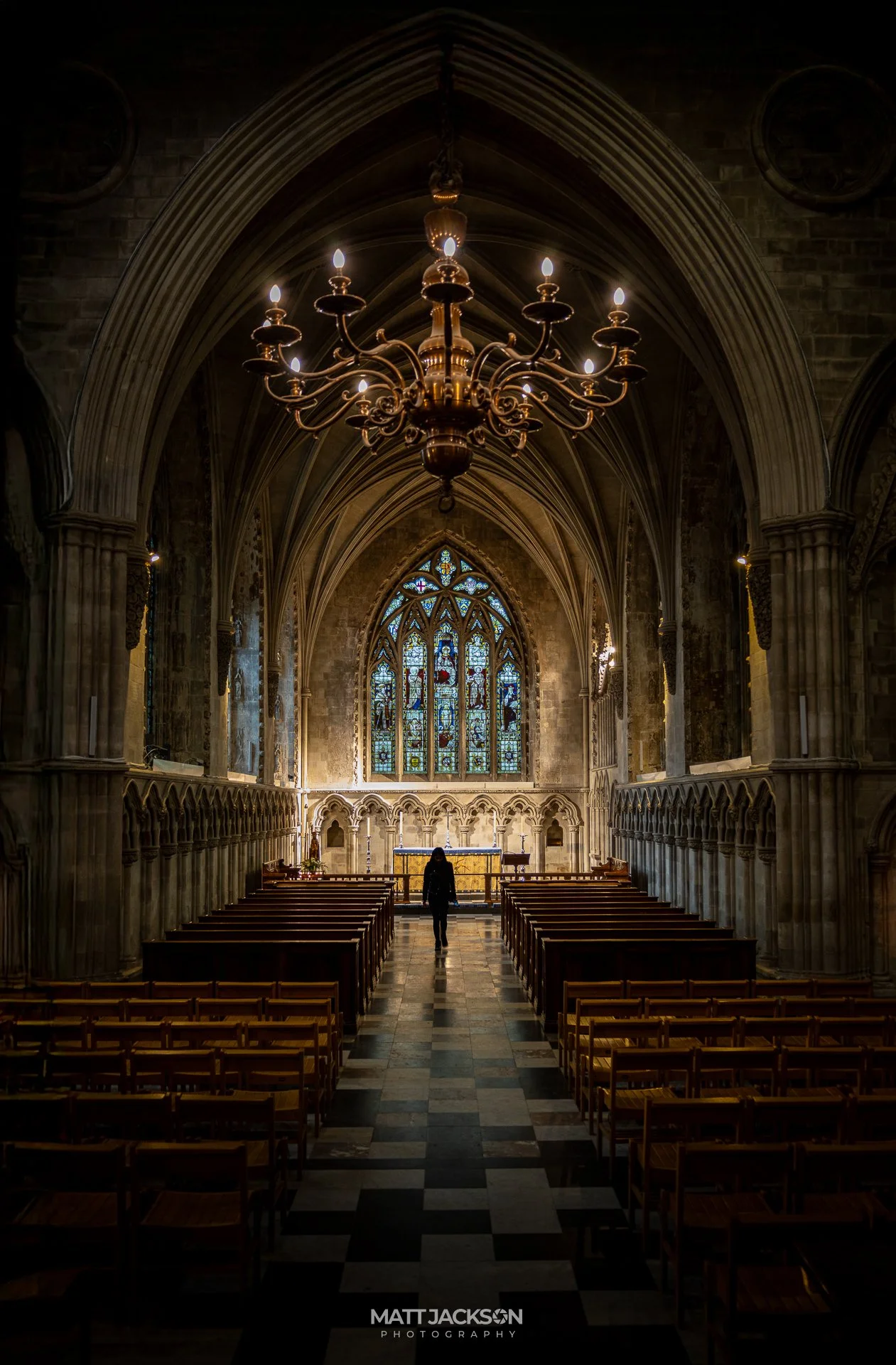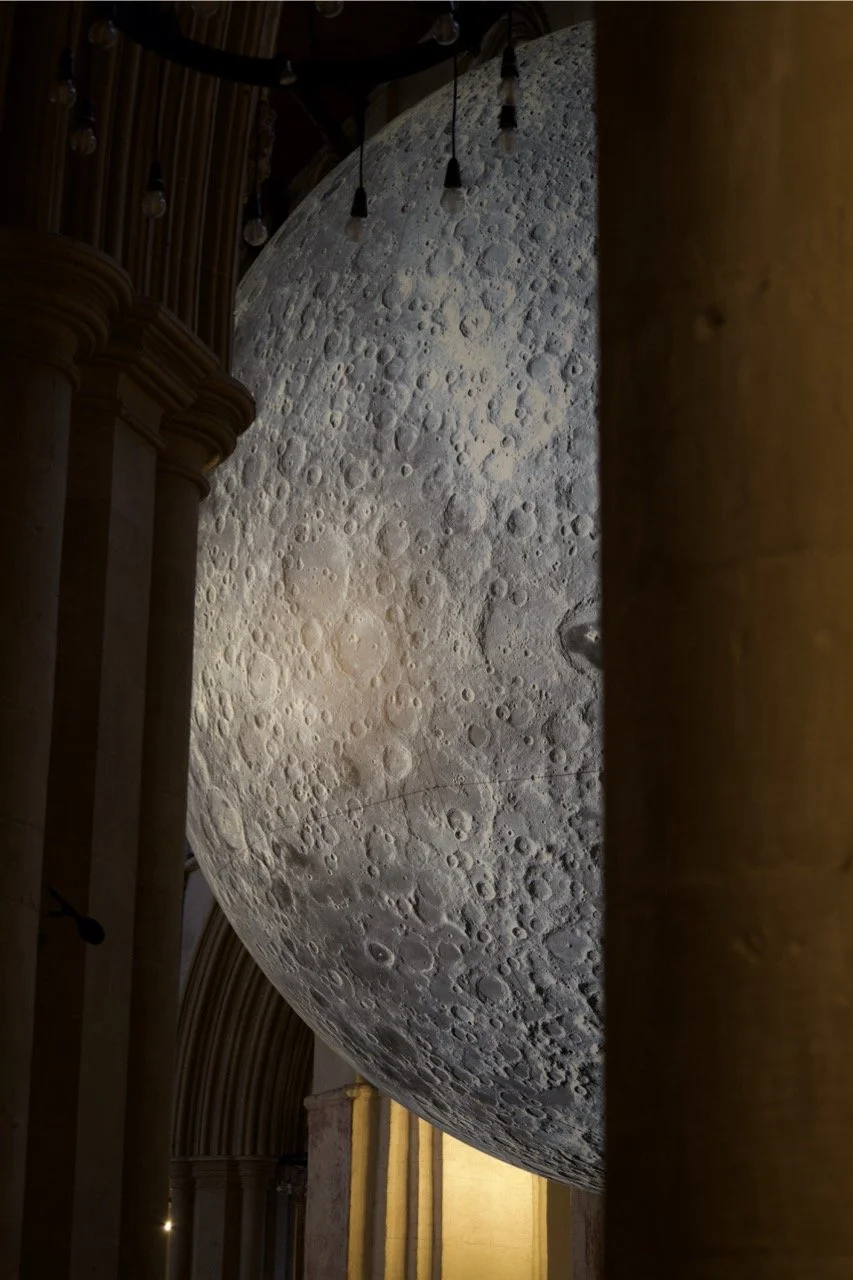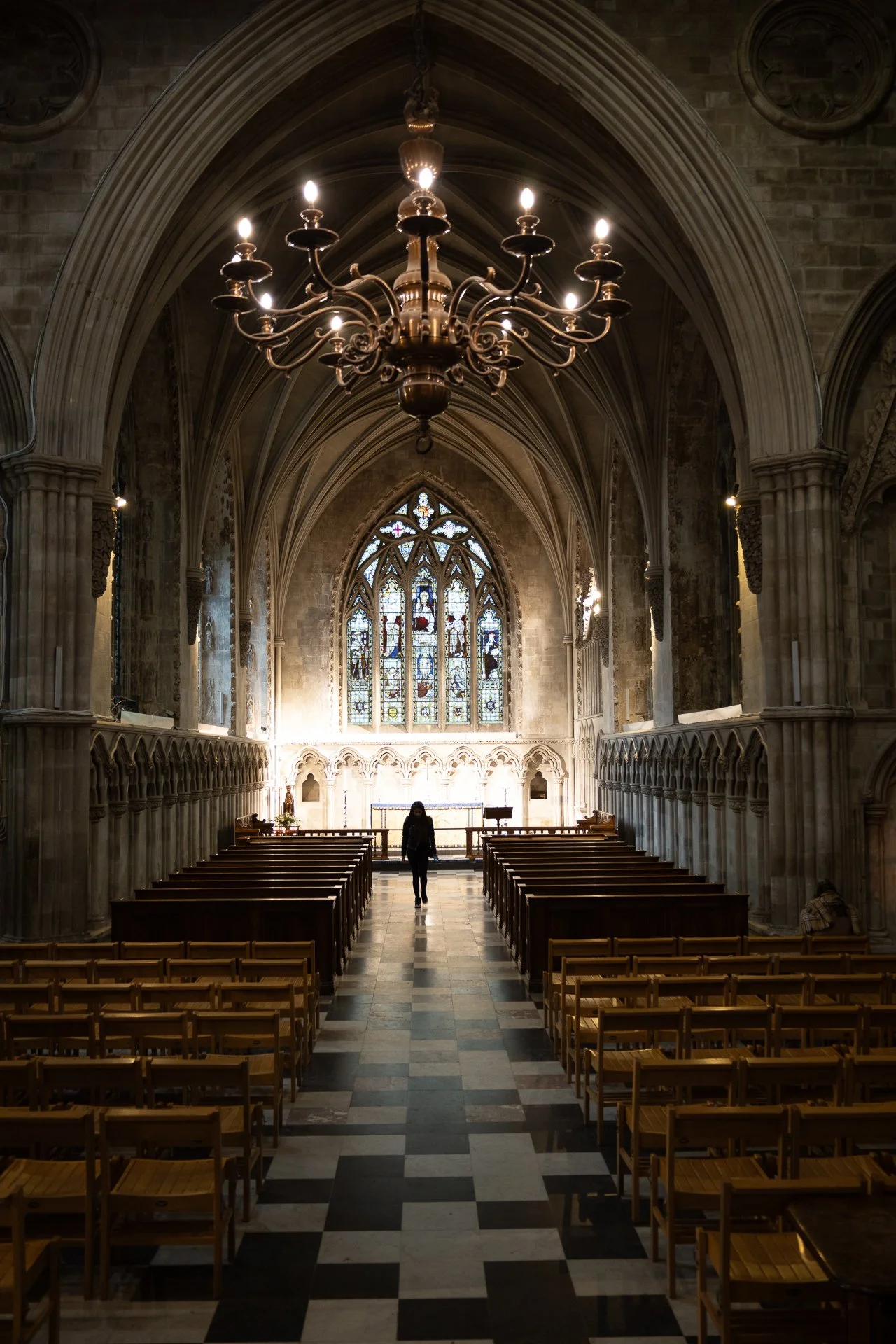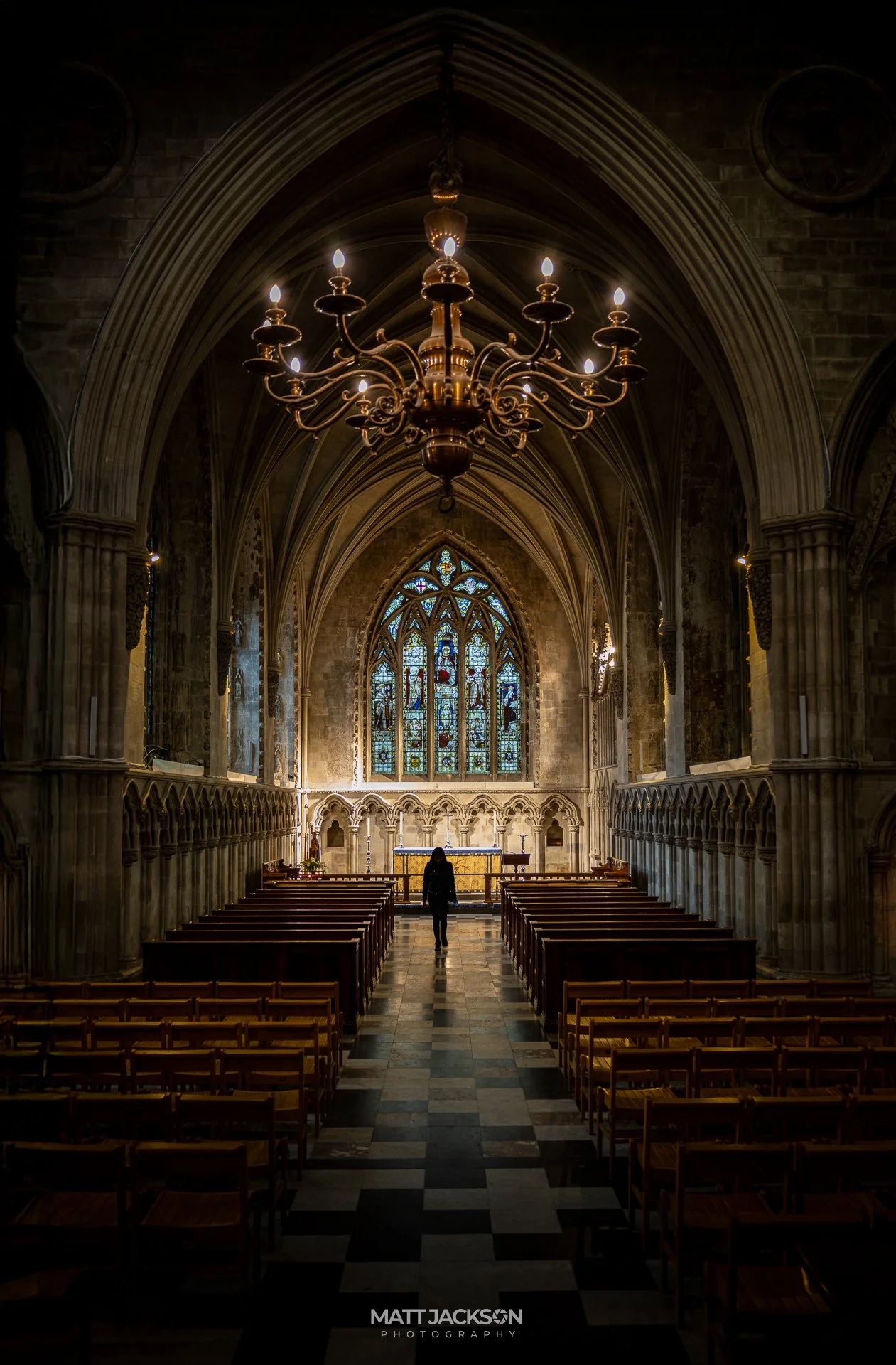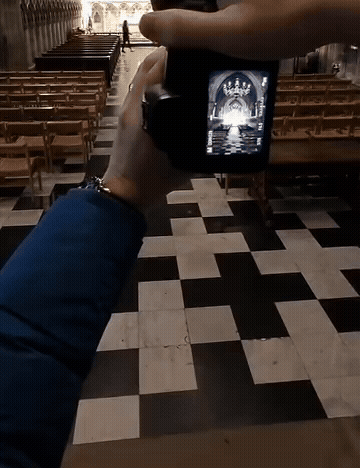The Photo That Didn’t Make It, But Made Me Better
The Photo in Question
I’d just received my Canon EOS R — a January 2025 purchase and, like any self-respecting camera nerd, I was itching to take it for a spin.
Sabrina and I decided to make a day of it. We headed to St Albans for no reason other than it being a beautiful place to wander 🏛️, shop 🛍️, and explore. And, of course, no trip out is complete without a strong coffee from Black Sheep — and cake 🍰. That part’s non-negotiable when you’re married to a German. Kaffee und Kuchen — if you know, you know ☕️.
I had no real photographic goals that day. No shot list, no golden hour ambitions. Just a new camera, a free afternoon, and a general willingness to see what I could learn.
We hadn’t planned to go inside the cathedral, but it was cold enough ❄️ to justify ducking in — and I’m glad we did. Sometimes having no plan is the best plan.
What we found inside was far more than just warmth. Towering medieval stonework, rows of intricate arches, and shafts of coloured light cutting through the gloom from the stained-glass windows — it was impossible not to feel a sense of quiet awe. To top it off, the cathedral was hosting a moon exhibit at the time — a massive glowing sphere suspended in the central nave. It felt otherworldly. Part ancient, part surreal, and completely spellbinding.
I’d read online about the Lady Chapel, said to be the most beautiful part of the entire building, tucked quietly at the far end. Naturally, I wanted to photograph it. The lighting, though, was another matter — dim and challenging, as you’d expect in a centuries-old structure.
Still, by the time we reached it, I felt like I’d started to understand the camera a bit better. I’d figured out what I thought was a good baseline for exposure — or at least, something close enough to feel brave behind the shutter.
Shooting With Intention
Once we reached the Lady Chapel, I knew exactly the kind of image I wanted: symmetry. The space almost demanded it — rows of pews leading straight to the stained-glass windows, a natural central axis running top to bottom. It made the composition feel obvious… but also risky. Get it right and it looks deliberate. Get it slightly off, and it just looks wrong.
I also wanted the chapel to be empty. Not for any technical reason — just to give the photo a sense of stillness. Sacred, undisturbed. So I waited.
Then, as if on cue, a woman quietly stepped forward to say a prayer.
I was already composed and ready. And as she turned and began walking back through the pews, silhouetted entirely by the stained glass behind her, I realised: this was the element I didn’t know I needed. The shot had gone from peaceful to purposeful. There was now a story — one of scale, solitude, and maybe even reverence — with just a single human shape.
The challenge, of course, was the lighting. I was exposing for the bright stained glass at the back, which threw everything else into deep shadow. She became a silhouette out of necessity, not design — though I’d like to pretend it was all part of the master plan 😅.
No tripods were allowed, which made things more complicated. I had to shoot handheld and make every adjustment count 🤏🏻. Shutter speed slow enough to let light in, but not so slow that it blurred. ISO just high enough to keep detail, but low enough to avoid mush. A balancing act — while still learning the feel of a brand new camera.
I had the 24–105mm “kit” lens on and no filters. Just me, the camera, and a vague idea of what I hoped would happen.
At the time, I didn’t even consider it as a magazine-worthy shot. That thought only hit me later, back at home, flipping through my monthly photography magazine — and seeing an entire spread discussing cathedral photography. Typical. The advice came just after I needed it.
The photo needed editing. What I thought was perfect symmetry turned out to be… not quite. Photoshop helped straighten things up — and, yes, I used a little AI generation to patch the edges where the alignment slipped.
The lighting was still a problem. The highlights were strong, to say the least — but I thought I’d managed to save them in post 💡. At least enough to hold the detail where it mattered. Or so I believed.
(We’ll come back to that.)
The Magazine Submission
Some time passed before the image even crossed my mind again. I’d been to a photography show in London — the kind where you spend the day floating between talks, stroking lenses you can’t afford, and pretending you definitely need a new bag for “workflow reasons.” But honestly, they’re brilliant. The people, the talks, the chance to hear from professionals — and yes, the opportunity to spend money you didn’t plan to 💸.
At one of the presentations, I ended up speaking to the editor and one of the writers/photographers from a well-known UK photography magazine. (I won’t name names, but there aren’t that many in circulation, so I’ll let you use your imagination.)
They were thoroughly lovely people, and during one of their talks I picked up some tips on how to submit to the magazine’s monthly Readers’ Gallery — an open invitation for photographers to share work across all genres. And that’s when it hit me: my cathedral photo. I was proud of that shot. I’d poured care into the composition, the edit, and it had meaning to me. Why not submit it?
So, when I got back home, I did exactly that. I followed the guidelines they’d talked about and sent it in. No big expectations — just curiosity and a bit of hope.
To my surprise, I heard back.
They liked it. In fact, they’d shortlisted it for final review for an upcoming issue.
I was buzzing.
Weeks passed, though, and I knew what that meant — no email likely meant no selection. But then… an email pinged in.
It read — in essence:
“Unfortunately they didn’t make it into the magazine this time but please keep sending your images through. Due to the number of photos that come in, and the fact that we’re busy creating the magazine for you, we can’t offer individual reasons why your image didn’t make it this time.”
I was a bit deflated, of course. But still proud. To have made it to the final cut against what I can only assume were some incredible entries — that meant something. And I still loved the photo. That hadn’t changed.
I sent a short thank-you reply — just to show appreciation.
And then something unexpected happened.
I got a proper reply. With actual feedback. The writer had taken the time to give me personal critique — and it changed everything.
Here’s what they said:
“Actually I will give you some feedback on the cathedral shot, as this was pretty close. The composition was perfect and the addition of a central figure made this really strong. The reason it didn’t make it was that the sunlight to the left has blown out the detail (if you have a RAW file I recommend looking to see if you can get a better version out of it) and that the chandelier overhead isn’t sharp enough, which is a depth of field and focussing issue. Obviously, lighting conditions in cathedrals are a nightmare, so I find it’s better to always shoot RAW and underexpose to preserve the highlights and rescue the detail in the shadows. There’s a metering mode on my camera called Highlight Metering which is ideal for these situations. If you don’t have that then perhaps use centre-weighted metering off the highlights, then recompose without re-metering. The sharpness/DOF issue is down to the fact that there’s usually very low light levels, so increasing the ISO so you can get a narrower aperture is one route, but also take heed of where you focus as this shouldn’t be the end of the shot but much further forward.”
I was over the moon.
(Not the one hanging in the cathedral — the metaphorical one.) 🌕
Real, professional critique. Not a brush-off. Not a vague “keep going.” But actual advice, based on my image.
I revisited the photo with fresh eyes. I hadn’t even noticed the small blown-out highlight on the left (told you we’d come back to that). And the focus — which I’d assumed was fine — now seemed soft in all the wrong places.
But that feedback? Invaluable. One paragraph of thoughtful critique taught me more than hours of tutorials ever had 🧠.
That one message made me grow.
What the Shot Taught Me
Looking back, that one photo taught me more than I expected — not just about exposure or composition, but about how I shoot.
First off, it reminded me to slow down. Even in time-sensitive moments. I couldn’t ask the lady to walk past again, or pause in just the right spot — but I could be ready. I could anticipate. And I could slow my own thinking down enough to know what I wanted before pressing the shutter 🐢.
It also reminded me not to worry so much about how many photos I take. This wasn’t a spray-and-pray situation — but even if it had been, that’s not the enemy. The real trick is to shoot with intention. Know why you’re taking the shot. But don’t beat yourself up if you see a mistake the moment you hit the shutter. Most of the time, you can adjust. You can reframe, recompose, or just learn something and carry it into the next photo.
Technically, I’ve learned a lot since then. How to recompose with more care. How to observe the whole frame — not just the subject. (Check the corners. Always check the corners 👀.) And how lighting, even subtle changes, can make or break a shot.
But it’s not just about gear or technique.
That image reminded me how much environment matters. The atmosphere in the cathedral that day was thick with quiet. I’m pretty sure the sound of the shutter echoed. It felt like every click had weight — like it meant something.
Moments like that remind you that photography isn’t just about pressing buttons. It’s about presence. About noticing what’s in front of you, and being ready to respond to it.
And that only comes from putting yourself in more situations like it. More scenes. More unknowns. That’s where the learning happens.
Final Thought
It’s strange how one click of the shutter can end up shifting your entire mindset.
This photo started as nothing more than a test run — a new camera, a cold day, and a spur-of-the-moment wander inside a cathedral. But from that single frame came so much more: excitement, pride, rejection, and eventually… growth.
I didn’t set out to create a magazine-worthy shot. I just wanted to see what I could do. And maybe that’s the point.
Every image is part of something bigger. A record of what you saw — but also a record of where you were, both technically and creatively.
Some photos will make it into galleries. Others will quietly live in your folders, just for you 💾. But all of them matter. All of them shape the photographer you’re becoming.
This one taught me a lot. And not just about exposure or focus — but about persistence, humility, and the value of staying open to feedback.
Because in the end, it’s all part of the journey.
And that journey is the real win.
For the Photographers
💡 Shooting indoors without a tripod? Here’s what I learned the hard way:
Shoot RAW — always. It’s your safety net for recovering shadows and salvaging detail you didn’t even know you captured.
Protect your highlights like they’re made of glass. Wrap them in cotton wool 🐑. Serenade them gently 🎻. Do whatever it takes not to blow them out. Underexpose slightly if you have to — you can bring back shadows, but once highlights are gone, they’ve packed their bags and left for good.
Bump your ISO if needed. A bit of noise is easier to fix than a blurry mess. Grain is character. Blur is regret. 😅
Focus smarter. In dim spaces, don’t just lock on to the background and hope for the best. Shift your focal point slightly forward to give your depth of field a fighting chance.
Meter creatively. If your camera has a Highlight Metering mode, use it. If not, try centre-weighted metering off the brightest part of your scene, lock it in, and then recompose. It’s a small tweak that can save a whole exposure.
✨ And lastly — be proud of what you create. Even if it’s not “perfect.” Because every image, every near-miss, and every unexpected email is helping you grow.


